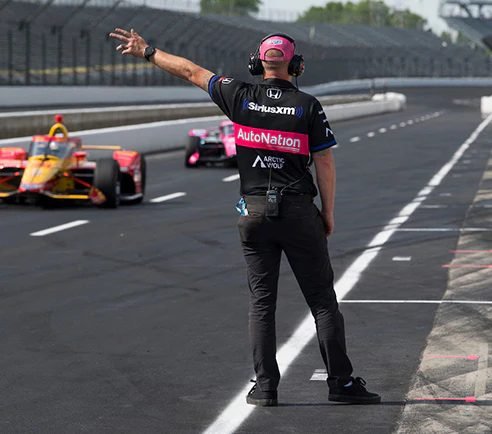Motorsport is thrilling. But it’s also inherently dangerous. Every time a driver straps into a race car, they’re accepting calculated risks. However, what many don’t realize is that proper safety equipment doesn’t just protect lives, it can dramatically reduce legal liability for drivers, teams, and event organizers.
The relationship between safety apparel and legal protection is complex and often misunderstood. While fire-resistant racing suits grab headlines, the complete safety system includes multiple layers of protection that work together to minimize both physical harm and potential legal exposure.
Recent regulatory changes have made safety equipment more sophisticated than ever. The FIA’s updated 8856-2018 standard requires enhanced fire protection that’s roughly 20% more effective than previous requirements. This isn’t just about driver safety, it’s about legal compliance in an increasingly regulated industry.
Understanding how safety equipment reduces liability risk requires examining the intricate web of insurance requirements, regulatory compliance, and legal precedents that govern modern motorsport. The stakes couldn’t be higher, with fire damage lawsuits causing billions in damages annually according to industry data.
Table of Contents
The Legal Framework of Motorsport Safety
Motorsport liability operates under a unique legal framework that differs significantly from standard personal injury law. Event organizers, sanctioning bodies, and drivers all share responsibility for safety compliance.
The Motorsport Responsibility Act in many jurisdictions requires facilities to maintain commercial general liability insurance of at least $1 million per person and $2 million aggregate. But here’s what’s crucial: this protection only applies when proper safety protocols are followed.
Racing organizations like Motorsport UK and the FIA have established comprehensive safety standards that aren’t just recommendations, they’re legal requirements. Failure to comply can void insurance coverage and expose participants to significant legal liability.
The key principle is “due diligence.” Courts expect motorsport participants to demonstrate that they’ve taken all reasonable precautions to minimize risk. This includes wearing appropriate safety equipment that meets current regulatory standards.
Professional drivers understand that racing shirts for drivers represent more than comfort, they’re a critical component of a legally compliant safety system.
Insurance Requirements and Coverage Gaps
Motorsport insurance is specialized and expensive. Standard policies won’t cover racing activities, creating a complex web of coverage requirements that participants must navigate carefully.
Personal accident insurance through organizations like Motorsport UK provides coverage for competitors and officials, but this protection comes with strict conditions. The insurance only applies when participants wear safety equipment that meets current homologation standards.
Commercial motorsport insurance providers like Marsh Sport and MIS Motorsport emphasize that proper safety equipment isn’t optional—it’s a prerequisite for coverage. Claims can be denied if investigators determine that non-compliant or damaged safety equipment contributed to an incident.
The insurance industry recognizes that fire-resistant undergarments can increase protection time by up to 40 seconds before second-degree burns occur. This additional protection time significantly reduces the severity of potential injuries and corresponding insurance payouts.
Event organizers face particular exposure, as they’re required to ensure all participants meet safety standards. A single non-compliant driver can expose an entire event to liability claims that could reach millions of dollars.
Fire Protection Standards and Legal Compliance
Fire remains the primary safety concern in motorsport, with racing suits designed to provide protection for 20-40 seconds depending on their rating. But legal compliance requires understanding the complete fire protection system.
The FIA’s 8856-2018 standard represents the current benchmark for fire-resistant clothing. This regulation covers everything from racing suits to underwear, gloves, and socks. Each component must work together to provide comprehensive protection.
SFI Foundation standards provide similar protection requirements in the United States. SFI 3.2A ratings range from 3.2A/1 (3 seconds of protection) to 3.2A/20 (40 seconds of protection). Higher ratings aren’t just safer, they’re often required for specific racing series.
The legal significance of proper fire protection became clear in recent court cases where manufacturers were held liable for injuries caused by non-compliant safety equipment. These precedents establish that using substandard equipment can result in significant legal exposure.
Fire-resistant racing underwear has become mandatory in many series, including NASCAR and Formula One. This requirement isn’t just about safety—it’s about legal compliance with evolving industry standards.
The Multi-Layer Protection System
Modern motorsport safety operates on a multi-layer protection principle. Each layer serves a specific purpose in both physical protection and legal compliance.
The base layer consists of fire-resistant underwear made from materials like Nomex or Kevlar. These garments provide the first line of defense against heat and flames while wicking moisture away from the skin to prevent heat exhaustion.
Racing suits form the primary protective barrier. Current regulations require one-piece suits with shoulder handles for emergency extraction. The suits must feature proper labeling showing compliance with current standards and expiration dates.
Head protection includes helmets meeting FIA 8860-2018 or Snell standards, plus fire-resistant balaclavas that extend down to meet the base layer. This seamless protection prevents gaps that could expose drivers to injury.
Hand and foot protection round out the system with fire-resistant gloves and shoes. Recent regulations have extended these requirements, making gloves longer and socks knee-length to eliminate potential exposure gaps.
The legal importance of this complete system cannot be overstated. Courts and insurance companies expect participants to demonstrate that they’ve implemented comprehensive protection measures, not just minimum compliance.
Regulatory Evolution and Legal Implications
Safety regulations in motorsport evolve rapidly, driven by technological advances and incident analysis. Staying current with these changes is essential for legal compliance.
The transition from FIA 8856-2000 to 8856-2018 standards represents a significant regulatory shift. While older equipment remains temporarily acceptable, the legal trend favors current standards in liability determinations.
New regulations require 10-year expiration dates on safety equipment, replacing the previous practice of using equipment indefinitely. This change has significant legal implications, as expired equipment could void insurance coverage.
Enhanced protection requirements include increased heat transmission protection and better coverage areas. These improvements reduce injury severity and corresponding liability exposure for all participants.
The introduction of biometric capabilities in gloves and other equipment creates new data sources for incident investigation. This technology can provide crucial evidence in legal proceedings, either supporting or undermining liability claims.
Cost-Benefit Analysis of Safety Investment
Investing in proper safety equipment represents a cost-benefit calculation that extends far beyond initial purchase prices. The legal and financial consequences of inadequate protection can be devastating.
High-quality racing suits range from $500 to $2,000, while complete fire-resistant underwear systems cost $200-500. These investments pale in comparison to potential legal costs from inadequate protection.
Insurance premiums often reflect safety equipment quality. Participants who invest in current-standard equipment may qualify for reduced premiums, while those using outdated gear face higher costs or coverage denial.
The hidden costs of safety equipment failure include legal defense expenses, potential settlements, and long-term reputation damage. Professional drivers understand that their safety equipment is essentially legal insurance.
Event organizers increasingly require participants to demonstrate compliance with current safety standards. Non-compliance can result in exclusion from events, impacting both competitive opportunities and earning potential.
Best Practices for Legal Protection
Implementing effective safety practices requires more than just buying equipment, it demands a systematic approach to legal compliance and risk management. Documentation is crucial. Participants should maintain records of all safety equipment purchases, including compliance certifications and expiration dates. This documentation becomes vital evidence in any legal proceedings.
Regular inspection and maintenance of safety equipment isn’t just good practice, it’s legally required. Damaged or contaminated equipment can void protection and create liability exposure. Training programs help ensure that all participants understand proper equipment use and maintenance. Many legal disputes arise from improper equipment use rather than equipment failure.
Professional consultation with safety equipment specialists can help navigate complex regulatory requirements. The investment in expert advice often pays dividends in legal protection and insurance compliance.
Staying informed about regulatory changes requires ongoing attention. Subscribing to official publications from organizations like the FIA, SFI Foundation, and relevant sanctioning bodies is essential for maintaining compliance.
Future Trends in Motorsport Safety Regulation
The motorsport safety landscape continues evolving rapidly, with new technologies and regulations emerging regularly. Understanding these trends is crucial for long-term legal compliance.
Biometric monitoring integration is expanding beyond gloves to include suit-embedded sensors that monitor heart rate, body temperature, and other vital signs. This technology will likely become standard in coming years.
Enhanced materials science is producing lighter, more effective protection systems. New Nomex formulations provide better protection while reducing weight and improving comfort. Digital compliance tracking systems are being developed to monitor equipment age, usage, and maintenance schedules. These systems will help ensure legal compliance while reducing administrative burden.
International harmonization efforts aim to standardize safety requirements across different motorsport jurisdictions. This trend will simplify compliance for participants competing in multiple series. The integration of artificial intelligence in safety equipment design promises more personalized protection systems. Custom-fitted equipment based on individual driver characteristics may become the new standard.
Practical Steps for Compliance
Achieving proper safety compliance requires systematic planning and ongoing attention to detail. Here’s a practical framework for ensuring legal protection through appropriate safety equipment. Start with a comprehensive audit of current safety equipment. Check all certification labels, expiration dates, and equipment condition. Replace any items that don’t meet current standards or show signs of wear. Develop a replacement schedule based on regulatory requirements and manufacturer recommendations. Helmets typically need replacement every 5-10 years, while suits and other equipment should be evaluated annually.
Establish relationships with certified safety equipment dealers who understand current regulations. These professionals can provide guidance on compliance requirements and help identify when updates are needed.
Create maintenance protocols for all safety equipment. Regular cleaning, inspection, and proper storage extend equipment life while ensuring continued protection. Document everything. Maintain records of purchases, inspections, maintenance, and any incidents involving safety equipment. This documentation becomes crucial evidence in any legal proceedings. Consider working with legal counsel familiar with motorsport liability issues. Understanding your specific exposure can help guide safety equipment decisions and ensure adequate protection.
The intersection of safety equipment and legal liability in motorsport represents a complex but crucial aspect of the sport. Proper fire-resistant apparel, including racing suits and underwear, serves dual purposes; protecting drivers from injury and protecting all participants from legal liability.
As regulations continue evolving and courts increasingly scrutinize safety practices, the importance of comprehensive protection systems will only grow. The cost of proper safety equipment represents a small investment compared to the potential legal and financial consequences of inadequate protection.
Modern motorsport demands a professional approach to safety that goes beyond minimum compliance. By understanding the legal implications of safety equipment choices and implementing comprehensive protection systems, participants can focus on what they do best: racing at the highest level with confidence in their protection. The future of motorsport safety lies in the continued evolution of both technology and regulation. Those who stay ahead of these trends will not only be safer on track but also better protected from the legal and financial risks that are an inevitable part of this demanding sport.


